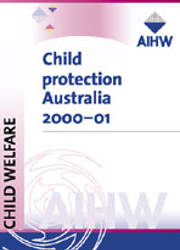Summary
This report is based on the following three national child protection data collections:
- child protection notifications, investigations and substantiations;
- children on care and protection orders; and
- children in out-of-home care.
These data are collected each year by the Australian Institute of Health and Welfare (AIHW) from the community services departments in each State and Territory. Most of the data in this report cover the 2000-01 financial year, although data on trends in child protection are also included.
Each State and Territory has its own legislation, policies and practices in relation to child protection, so there are differences between jurisdictions in the data provided. Australian totals have not been provided for those data that are least comparable across the States and Territories.
The main points of interest in the report are as follows:
- Over the last 5 years the number of child protection notifications in Australia increased from 91,734 in 1995-96 to 115,471 in 2000-01. Over this period the number of notifications increased in all jurisdictions except Western Australia, Tasmania and the Australian Capital Territory (Table 2.3).
- Between 1995-96 and 2000-01 the number of substantiations across Australia decreased from 29,833 to 27,367. This decrease appears to be primarily due to changes in policies and practices in different jurisdictions (Table 2.4).
- Rates of children who were the subjects of child protection substantiations in 2000-01 ranged from 0.9 per 1,000 children aged 0-16 years in Tasmania to 7.4 per 1,000 in Queensland (Table 2.7).
- There was a continuing upward trend Australia-wide in the numbers of children on care and protection orders and the numbers in out-of-home care. The numbers of children on care and protection orders increased from 15,718 at 30 June 1997 to 19,783 at 30 June 2001, while the numbers of children in out-of-home care increased from 14,078 to 18,241 over the same period (Tables 3.5 and 4.3).
- At 30 June 2001 there were 4.2 children per 1,000 on care and protection orders and 3.9 per 1,000 in out-of home care (Tables 3.9 and 4.7).
- While the quality of the data on Indigenous status varies between States and Territories, Aboriginal and Torres Strait Islander children were clearly over-represented in the child protection system.
- The rate of Indigenous children who were the subjects of substantiations, for example, was more than seven times the rate for other children in Western Australia and South Australia (Table 2.9). Across Australia the rate of Indigenous children on care and protection orders and the rate of Indigenous children in out-of-home care was over six times the rate for other Australian children (Tables 3.10 and 4.8).



